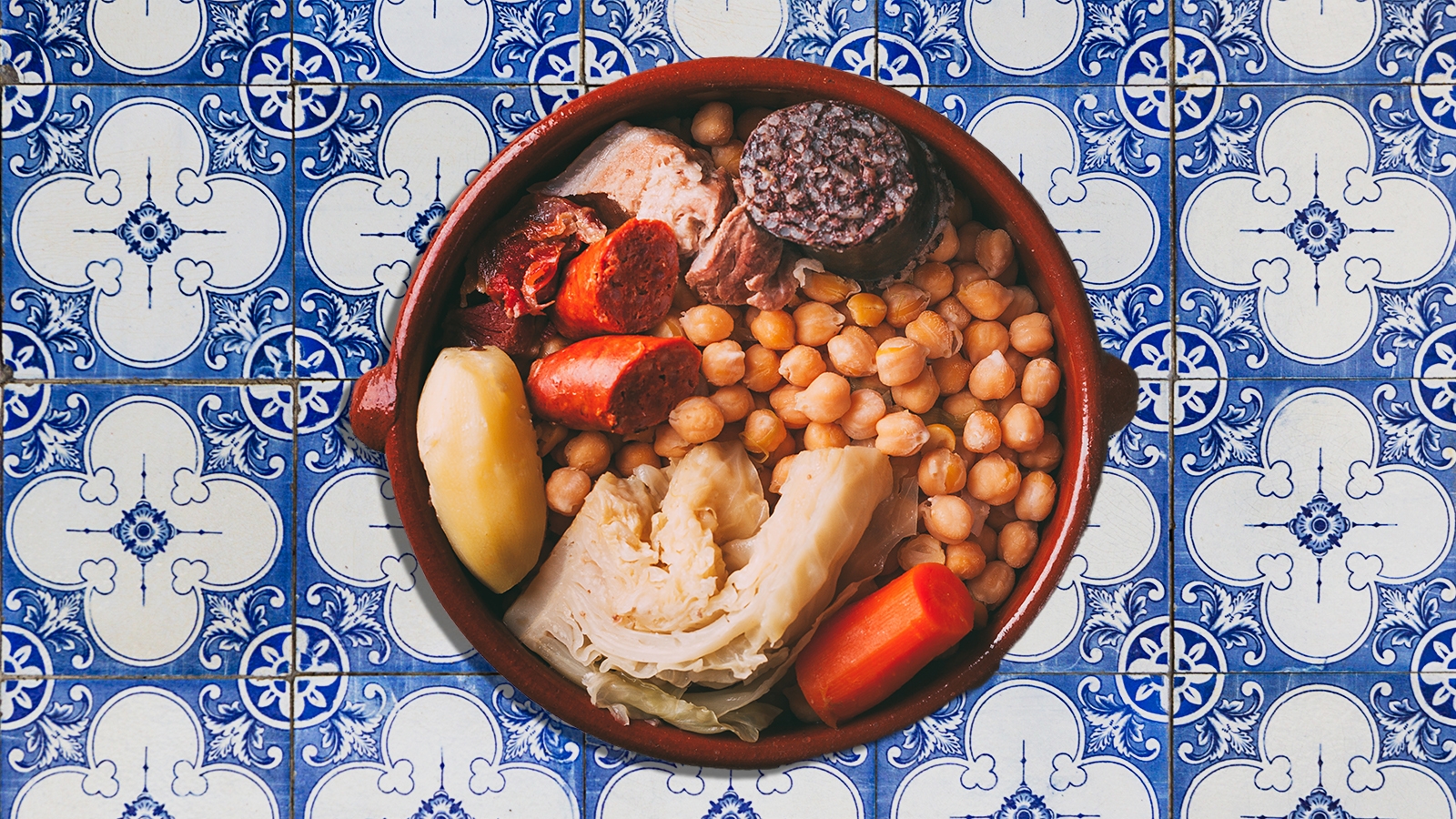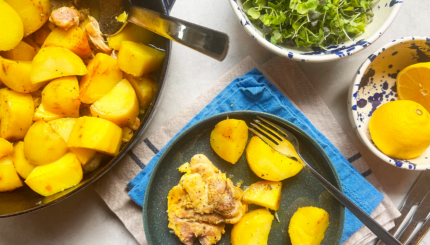La Bola is a classic Madrid tavern. Located on a quiet backstreet, it is painted lacquer red on the outside, with a dark wood and colored tile interior. We arrived during a busy Sunday lunch service. The place was filled with multigenerational families and loud groups of friends who, like us, were there for the jewel of the crown, the most Madridian dish of all: Cocido madrileño, a stew that La Bola has perfected in its 150 years of operation.
Cocido madrileño (“the stew of Madrid” in Spanish) is a rustic dish of chickpeas, vegetables such as potatoes and cabbage, and a variety of pork cuts, sausages and marrow bones. At La Bola it is still cooked the traditional way, layered in individual clay pots over coal. The stew is served over two courses, making for a full meal. First, the busy waiter poured the cooking liquid out of the cocido pot into a soup bowl filled with vermicelli noodles, to be eaten like a soup. The chickpeas, vegetables and meats were placed on a platter for the main course (some serve the chickpeas for a second course and the meat with veggies for third). The scene repeated itself at almost every table in the packed restaurant, with guests watching in anticipation as the waiters laid out the cocido spread.
But as it turns out, the roots of this Madrid staple, this pork-laden stew, are deep in the medieval Sephardi community of Spain. Specifically, in a Shabbat overnight stew called adafina (AKA dafina, tfina and s’khina).
To understand the dish’s amazing evolution, we need to look way back.
The Nosher celebrates the traditions and recipes that have brought Jews together for centuries. Donate today to keep The Nosher's stories and recipes accessible to all.
Muslims conquered the Iberian Peninsula in the early eighth century. They brought religious moderation to Al Andalus, in addition to new dishes, spices, fruits and cooking techniques. Since Jews and Muslims both avoid pork, their cuisines at the time were very similar.
Cooking stews overnight, over or under coal, was a technique used by Muslims while still in the Levant. But in Al Andalus, it was the Jews who were most identified with this cooking method, mainly because it was a good practice for Shabbat, when lighting fire is not allowed. The word adafina comes from the Arabic word for “hidden” or “buried,” since the dish was cooked while buried under coal, though the dish is also known as ani or calinete (“hot” in Spanish) or hamin (“a warm dish” in Hebrew, a name that was used for Shabbat dishes in the Talmud).
Adafina, just like cocido madrileño, consists of chickpeas, vegetables, meat (lamb) with the occasional addition of hard-boiled eggs (huevos haminados) cooked together at a low temperature overnight. Adafina is still prepared by Tunisian and Moroccan Jews of Sephardi descent around the world. Through the years, more ingredients were added to the pot, most notably potatoes from the new world, as well as wheat berries, sometimes tied in a cloth, and a sweet loaf of ground beef.
According to author and food historian Claudia Roden, Moroccan adafina was served in several courses, first potatoes and eggs with plenty of the soup, then the wheat and/or rice and lastly the meat with chickpeas. Just like the cocido is served in Madrid today.
The first cookbook available to us from the Iberian Peninsula is the 13th century Andalusian “Kitab Al Tabikh.” It includes six Jewish recipes, and two of them use the technique of covering the pot with another pot of coal to keep it warm. A third recipe, described as “Stuffed, Buried Jewish Dish,” is called Madfūn, an Arabic word that comes from the same root as adafina, to bury. Although the recipe is different to what we know as adafina today, the method of cooking it for a long time under coal is the same.
With the expulsion of the Jews from Spain in 1492, many left to Portugal, North Africa and the Ottoman Empire, where for 500 years they kept their prayers, language (Judeo-Spanish or Ladino) and their unique cuisine, which is why adafina is present in Moroccan homes today.
Those who stayed in Spain were forced to convert to Catholicism. To enforce the sincere conversion and prevent the conversos (converts) from practicing their Judaism in secret, the monarchy used the Inquisition, an institution that kept its devastating work well into the 19th century.
One of the ways the Inquisition spied on and convicted heretic conversos was by observing their food. They published guides with detailed descriptions of Shabbat dishes, matzah on Passover, eggplant dishes and the avoidance of pork. Interestingly, the conversos themselves, having no other resource available, used those same lists in order to learn how to keep their Jewish customs alive. Neighbors and servants reported their suspicions to the Inquisition authorities. And so adafina became one of the most incriminating dishes, punishable by cruel execution.
A letter written by an eager informer to King Ferdinand in 1516 says that “nearly all the residents of this city [Seville] smell Jews, them, their houses and the doors of their houses, because they are gluttons and pigs, and they nourish themselves with casseroles, garlic and adafinas,” as documented in Hélène Jawhara Piñer’s book “Jews, Food, and Spain.”
But if the roots of cocido madrileño are, in fact, in the Jewish Sephardi adafina, why is it full of pork?
While many conversos saw avoiding pork as the most important Jewish law to keep, others deliberately consumed pork in public in order to avoid any suspicion. “The conversos of Majorca were known as Xuetes (“xua” meaning “bacon” in Majorcan Catalan), explains Paul Freedman in his book “Why Food Matters.”
“Because their ancestors cooked and ate bacon in public to show their sincerity, but they only did this once or twice a year.”
“The one way to demonstrate that they [the conversos] now are Christian was to eat pork, so they introduced pork into the most famous dish they ate, adafina,” Mara Verdasco Arevalo, La Bola Tavern’s manager and owner, told me in an email.
For hundreds of years after the expulsion, Spain had no Jewish community and the Jewish roots of many staples of Spanish cuisine were all but forgotten. In recent years, Spain has been making an effort to revive its elaborate Jewish history. Spanish governments have worked to renew Jewish quarters around the country, began issuing Spanish passports to Sephardim and opened new Jewish museums. Hopefully a thorough research of Spain’s culinary heritage, acknowledging the Muslim and Jewish roots, will be part of it.



